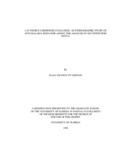| dc.description.abstract | Malaria is re-emerging with a vengeance after near eradication a generation ago. In
Africa, it kills between 1 and 2 million people, mostly children, each year and many more
are incapacitated leading to enormous human and economic loss. I present data on
responses to malaria among the Abagusii, an agricultural, Bantu-speaking people who
inhabit the fertile rainy highlands of southwestern Kenya. Data on knowledge of common
illnesses in Bomorenda, the site for the study, and malaria symptoms, were collected using
systematic ethnographic methods. Malaria-focused narratives from 35 informants yielded
additional ethnographic information of lay people’s responses.
The study reveals that Abagusii have multiple notions of malaria causation. A
majority (85.7%) consider the mosquito as the major cause of malaria. Other causes
are eating sugary foods (57.1%) and witchcraft (34.3%). They assign naturalistic
causation as well as associate malaria with environmental dangers. These findings support
the indigenous contagion theory. Abagusii recognize the same symptoms as those in the
clinical case definition of malaria. Using symptom salience as a measure of importance,
headache (salience = .447), shivering (.393), fever (.226), vomiting (.188) and paining
joints (.158) are the top five symptoms.
Transition state probability results show that the longer the illness lasts, the more
likely that the illness will be treated outside the home (transition probability =.772). Over
82% of lay people report self-treatment as a first choice (t). The percentage of people who
use self-treatment drops to 12.5% at the time of second choice (t+1) and zero at time
three (t+2) while those who seek treatment outside the home increases. Illnesses that last
long are regarded as serious and patients prefer taking those illnesses to private or public
health care facilities where they are likely to get specialized attention (Fisher’s exact test p
< .0001, Cramer’s V = .719).
Lay people in Gusii purchase a variety of drugs for malaria management from local
shops. A cognitive map of informants reveals that they arrange these drugs along a
dimension based on age of the patient and along a malaria–analgesic drugs dimension.
Although informants have good knowledge regarding drug dosage, sometimes they get
wrong information about the administration of different drugs. This has implications for
the immediate management of malaria and for the long-term effects of improper use
including the development of drug resistant parasites. Three quadratic assignment
procedure (QAP) analyses indicate no gender differences with regard to lay people’s
responses to malaria-focused ethnographic interviews and similarity among illnesses and
malaria drugs. The r-square for the three QAP analyses range between 0.72 and 0.88.
A biocultural model is used to show that ecological and cultural factors play an
important role in sustaining mosquito density in Bomorenda. Farming practices and type
of houses constructed provide optimal conditions for Anopheline mosquitoes that transmit
Plasmodium parasites. The utility of the biocultural model is assessed and policy
implications drawn. | |

